

Fish eat plastic like teens eat fast food, researchers say. Image copyright Oona Lonnstedt Young fish become hooked on eating plastic in the seas in the same way that teenagers prefer unhealthy fast food, Swedish researchers have said.
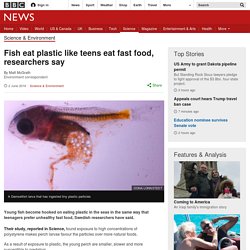
Their study, reported in Science, found exposure to high concentrations of polystyrene makes perch larvae favour the particles over more natural foods. As a result of exposure to plastic, the young perch are smaller, slower and more susceptible to predators. The researchers called for plastic micro-beads to be banned in cosmetics. Chemical degradation Concerns have been growing about the amount of plastic in the seas in recent years. A study that came out last year estimated that about 8 million tonnes of plastic waste enters the oceans annually. Marine problems: Pollution. Seas of garbage Solid garbage also makes its way to the ocean.
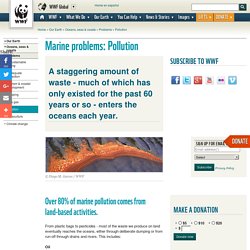
Plastic bags, balloons, glass bottles, shoes, packaging material – if not disposed of correctly, almost everything we throw away can reach the sea. Plastic garbage, which decomposes very slowly, is often mistaken for food by marine animals.
Illegal Wildlife Trade. The world is dealing with an unprecedented spike in illegal wildlife trade, threatening to overturn decades of conservation gains.

Ivory estimated to weigh more than 23 metric tons—a figure that represents 2,500 elephants—was seized in the 13 largest seizures of illegal ivory in 2011. Poaching threatens the last of our wild tigers that number as few as 3,200. Wildlife crime is a big business. Run by dangerous international networks, wildlife and animal parts are trafficked much like illegal drugs and arms. Illegal Poaching — SEE Turtles. Whaling Information and Whale Hunting Facts. Whaling is cruel and the demand for whale meat is falling.
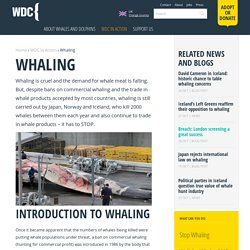
But, despite bans on commercial whaling and the trade in whale products accepted by most countries, whaling is still carried out by Japan, Norway and Iceland, who kill 2000 whales between them each year and also continue to trade in whale products – it has to STOP. Once it became apparent that the numbers of whales being killed were putting whale populations under threat, a ban on commercial whaling (hunting for commercial profit) was introduced in 1986 by the body that regulates whaling – the International Whaling Commission. However, over 30,000 whales have been killed since the ban came into effect because of loopholes that have allowed some countries to carry on whaling.
The International Whaling Commission currently allows Norway to hunt under an ‘objection’ to the ban, and Japan uses a loophole which allows countries to hunt whales for ‘research purposes’. Frequently asked questions about whaling. Threats to oceans and coasts. Marine Habitat Destruction. Habitat destruction occurs when the conditions necessary for plants and animals to survive are significantly compromised or eliminated.
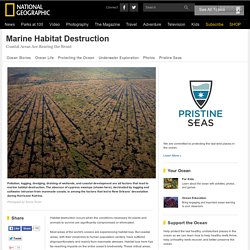
Most areas of the world's oceans are experiencing habitat loss. But coastal areas, with their closeness to human population centers, have suffered disproportionately and mainly from manmade stresses. Habitat loss here has far-reaching impacts on the entire ocean's biodiversity. Human Impacts. Humans can have a significant impact of the biology of the ocean where we alter its chemical composition.
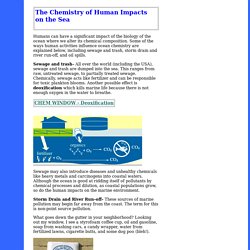
Some of the ways human activities influence ocean chemistry are explained below, including sewage and trash, storm drain and river run-off, and oil spills. Sewage and trash- All over the world (including the USA), sewage and trash are dumped into the sea. This ranges from raw, untreated sewage, to partially treated sewage. Chemically, sewage acts like fertilizer and can be responsible for toxic plankton blooms. Another possible effect is deoxification which kills marine life because there is not enough oxygen in the water to breathe. Sewage may also introduce diseases and unhealthy chemicals like heavy metals and carcinogens into coastal waters. Storm Drain and River Run-off- These sources of marine pollution may begin far away from the coast. What impacts do humans have on the ocean? What impacts do humans have on the ocean?
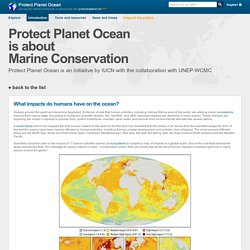
Unsustainable fishing. As coastal and pelagic (open ocean) fisheries around the world have collapsed, fishing effort has shifted to the deep sea and previously unexploited fish species.
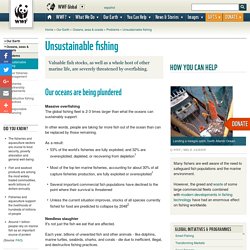
Here, overfishing can quickly deplete local fish populations - even within a single season. Some newly fished populations, such as monkfish, Patagonian toothfish, blue ling, and orange roughy, have already collapsed in some areas. There is insufficient data on other populations to determine what level of fishing is sustainable. At present most deep-water species are likely to be over-exploited - and as many as 40% of the world’s fishing grounds are now in waters deeper than 200m. The impacts of declining fish catches are being painfully felt by many coastal fishing communities around the world. Outlook: Human's Impact on the Oceans. CORAL REEF DESTRUCTION AND CONSERVATION - Coral Reefs - Ocean World. CORAL REEF DESTRUCTION and CONSERVATION Ten percent of the world's reefs have been completely destroyed. Human impacts on marine environments. Throughout human existence we have relied on the oceans – for food, as a waste dump, for recreation, for economic opportunities and so on.
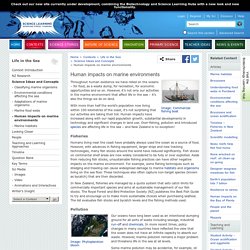
However, it’s not only our activities in the marine environment that affect life in the sea – it’s also the things we do on land. With more than half the world’s population now living within 100 kilometres of the coast, it’s not surprising that our activities are taking their toll. Human impacts have increased along with our rapid population growth, substantial developments in technology and significant changes in land use.